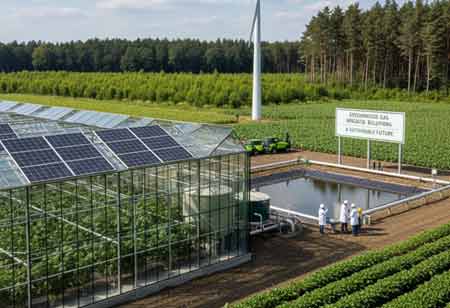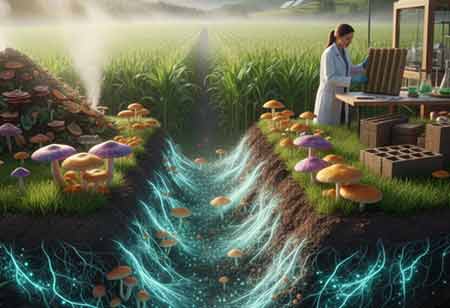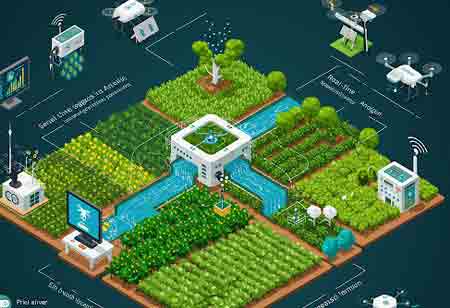Thank you for Subscribing to Agri Business Review Weekly Brief
Agroforestry and Silvopasture: Nature-Based Solutions for Emissions Reduction
Agroforestry and silvopasture are nature-based practices that reduce emissions, enhance biodiversity, improve water management, and provide economic benefits, supporting a sustainable agricultural future.

By
Agri Business Review | Thursday, December 11, 2025
Stay ahead of the industry with exclusive feature stories on the top companies, expert insights and the latest news delivered straight to your inbox. Subscribe today.
In the global pursuit of a sustainable future, the focus is increasingly shifting towards solutions that work in harmony with nature rather than against it. As industries worldwide pivot to address their environmental footprint, the agricultural sector stands at a unique and powerful crossroads. It holds the potential not only to reduce its emissions but to actively draw down atmospheric carbon, transforming landscapes into significant climate assets. At the forefront of this transformation are two interconnected, science-backed practices: agroforestry and silvopasture. These nature-based solutions represent a paradigm shift in land management, offering a robust pathway to significant emissions reduction while building resilient and productive food systems.
The Scientific Engine of Carbon Sequestration
The climate mitigation power of agroforestry and silvopasture is rooted in fundamental ecological processes, primarily the capture and long-term storage of atmospheric carbon. These systems operate as powerful biological carbon pumps, addressing greenhouse gas emissions on multiple fronts.
The most visible mechanism is carbon sequestration in woody biomass. Through the process of photosynthesis, trees absorb atmospheric carbon dioxide (CO₂) and convert it into organic matter, storing carbon in their trunks, branches, and leaves. As these trees mature over decades, they become substantial, long-term reservoirs of carbon, effectively locking it away from the atmosphere.
Equally, if not more important, is what happens below ground. The absolute powerhouse of carbon storage in these systems is the soil. The continuous addition of organic matter from leaf litter, pruned branches, and the natural turnover of fine roots enriches the soil, steadily increasing its soil organic carbon (SOC) content. The extensive root systems of trees create channels that extend deep into the soil profile, depositing carbon far below the surface, where it is more stable and less susceptible to decomposition. These roots foster symbiotic relationships with vast networks of mycorrhizal fungi, which play a crucial role in sequestering carbon and developing a healthy, resilient soil structure. A landscape rich in SOC is not just a carbon sink; it is also more fertile and water-retentive.
Beyond direct sequestration, these integrated systems help to avoid emissions in the first place. The natural nutrient cycling, where decomposing leaf litter enriches the soil, reduces the dependency on synthetic nitrogen fertilizers. The industrial production of these fertilizers is energy-intensive, and their application is a significant source of nitrous oxide (N₂O), a greenhouse gas that is nearly 300 times more potent than CO₂. By fostering natural soil fertility, agroforestry and silvopasture mitigate a significant source of agricultural emissions.
A Cascade of Co-Benefits
While the potential for emissions reduction is a primary driver of their adoption, the appeal of agroforestry and silvopasture is further enhanced by a wide array of co-benefits that improve both ecological and agricultural resilience.
The structural complexity of these systems creates diverse habitats, fostering a significant increase in biodiversity compared to monoculture landscapes. The trees, shrubs, and varied ground cover provide food and shelter for pollinators, beneficial insects, birds, and other wildlife, restoring ecological balance and function. This enhanced biodiversity contributes to natural pest control and pollination services, which are vital for agricultural productivity.
Water management is profoundly improved. The tree canopy intercepts rainfall, reducing the impact of heavy downpours and minimizing soil erosion. The enhanced soil structure, rich in organic matter, acts like a sponge, increasing water infiltration and retention. This recharges groundwater aquifers, ensuring that more water is available to crops and forage during dry periods. By reducing surface runoff, these systems also act as natural filters, preventing soil and nutrients from entering waterways and thus protecting water quality.
In an era of increasing climate volatility, these integrated systems offer inherent resilience. Trees serve as natural windbreaks, protecting crops and soil from wind damage. The shade from their canopies moderates temperatures at the ground level, protecting sensitive crops from extreme heat and reducing heat stress in livestock. This microclimate regulation makes the entire farm system more robust and adaptable to climate extremes such as droughts and heatwaves. For livestock in silvopastoral systems, the benefits are direct and observable. Access to shade and shelter improves animal welfare and health, which in turn enhances productivity and overall well-being. Particular tree species can also be used as a supplementary source of fodder, providing high-protein forage, especially during seasons when grass availability is low.
The Enabling Landscape and Future Horizon
The industry is witnessing a significant convergence of interest from multiple sectors. A new economic architecture is emerging around ecosystem services, where land managers can be financially rewarded for the environmental benefits they generate. Carbon markets, both voluntary and compliance-based, are providing a clear financial incentive for adopting practices that sequester measurable amounts of carbon. This allows farmers and ranchers to diversify their income streams, generating revenue not just from their agricultural products but also from the carbon stored in their trees and soil.
This momentum is being matched by growing policy support. Governments and international bodies are increasingly recognizing nature-based solutions as a critical component of national and global climate action plans. This recognition is translating into supportive policies, technical assistance programs, and public-private partnerships aimed at scaling up the adoption of agroforestry and silvopasture. Investment is flowing from both public and private sources into research and innovation, further refining best practices and developing tools to accurately monitor, report, and verify the carbon sequestration and other ecological benefits these systems provide.
Agroforestry and silvopasture are poised to become cornerstones of a regenerative agricultural future. They are not a regression to past methods but a sophisticated, forward-looking application of ecological principles to modern land management. They offer a tangible, scalable pathway to address the climate crisis, enhance biodiversity, ensure food security, and build prosperous rural economies. Reintegrating trees into agricultural landscapes further contributes to establishing a resilient, productive, and truly sustainable foundation for future generations.





